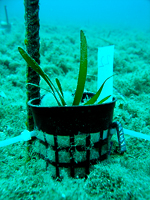ABSTRACT
Marine aquaculture is an activity that has induced severe local losses of seagrass meadows along the coastal areas. The purpose of this study was to evaluate the capacity of an area degraded by fish-farm activities to support Posidonia oceanica seedlings. In the study site, a bay in the southeast coast of Spain where part of a meadow disappeared by fish-farm activities, seedlings inside mesh-pots were planted in three areas.
Two plots were established in each area, one in P. oceanica dead matte and another inside a P. oceanica meadow. To evaluate if sediment conditions were adequate for the life of the seedlings, half of them were planted in direct contact with the sediment and the other half were planted above the surface of the sediment in each plot.
Monitoring during 1 year showed that there were large differences in seedling survival between the dead matte and the P. oceanica meadow. While seedlings planted in dead matte had a high survivorship after 1 year (75%), seedlings planted in P. oceanica progressively died (survivorship of 20% after 1 year).
The average leaf length of the seedlings surviving in the two substrata was not different, but the leaf area per seedling was lower in the seedlings growing inside the P. oceanica meadow during most part of the year. Seedling survivorship and vegetative development were not affected by the level of planting and suggest that the sediment conditions are adequate for the life of P. oceanica seedlings.









